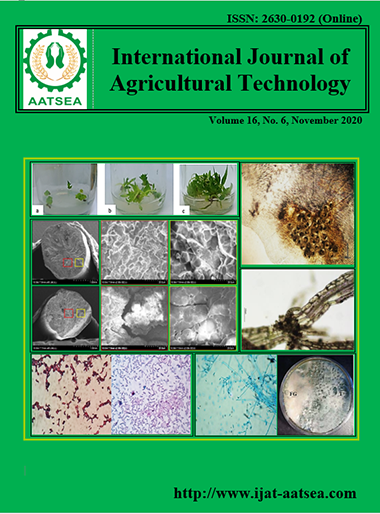Serratia marcescens KMITL2020 as a plant growth stimulant and bacterial antagonist to control brown leaf spot of rice caused by Drechslera oryzae
Main Article Content
Abstract
Serratia marcescens KMITL2020 proved to be growth stimulat and antagonistic to Drechslera oryzae causing brown leaf spot of rice caused by Drechslera oryzae. The brown leaf spot disease was isolated the causal agent which identified as Drechslera oryzae. Bi-culture test between D. oryzae and S. marcescens KMITL2020 inhibited spore production of the tested pathogen 44.12 %. It showed that crude extract from S. marcescens KMIT2020 gave effectively against D. oryzae which the effective dose (ED50) was 92.57 µg/ml. Result showed crude extract from S. marcescens and carbendazim treatments significantly controlled brown leaf spot caused by D. oryzae which reduced the disease of 25 % when compared to the non-treated control in 28 days. Plant growth parameters revealed that crude extract from S. marcescens gave significantly higher tillers, plant height, plant fresh weight, root fresh weight, plant dried weight, root dried weight than carbendazim treatment when compared to the non-treated control.
Article Details

This work is licensed under a Creative Commons Attribution-NonCommercial-NoDerivatives 4.0 International License.
References
Chakraborty, U., Chakraborty, B. and Chakraborty, A. P. (2010). Influence of Serratia marcescens TRS-1 on growth promotion and induction of resistance in Camellia sinensis against Fomes lamaoensis. Journal of Plant Interactions, 54:261-272.
Brigida Pimentel Villar de Queiroz and Itamar Soares de Melo. (2006). Antagonism of Serratia marcescens towards Phytophthora parasitica and its effects in promoting the growth of citrus. Brazilian Journal of Microbiology, 37:4.
El Khaldi, R., Daami-Remadi, M., Hamada, W., Somai, L. and Cherif, M. (2015). Date palm compost as biocontrol agent of rhizoctonia solani on potato. Journal of Plant Pathology and Microbiology, S:3. DOI: 10.4172/2157-7471.S3-006.
de Queiroz, B. P. V. and de Meo, I. S. (2006). Antagonism of Serratia marcescens towards Phytophthora parasitica and its effects in promoting the growth of citrus. Brazilian Journal of Microbiology, 37:448-450.
IRRI (Rice Knowledge Bank) (2019). Retrieved from http://www. knowledgebank.irri.org/training/fact-sheets/pest management/diseases/item/ brown-spot.
Islam, K. Z. and Nandi, B. (1985). Control of brown spot of rice by Bacillus megaterium. Journal of Plant Diseases and Protection, 92:241-246.
Jaiganesh, V., Eswaran, A., Balabaskar, P. and Kannan, C. (2007). Antagonistic activity of serratia marcescens against Pyricularia oryzae. Notulae Botanicae Horti Agrobotanici Cluj-Napoca, 35:48-54.
Wang, K., Yan, P., Cao, L., Ding, Q., Shao, C. and Zhao, T. (2013). Potential of Chitinolytic Serratia marcescens Strain JPP1 for biological control of Aspergillus parasiticus and Aflatoxin. Retrieved from: https://doi.org/10.1155/2013/397142, ID 397142.
Karunasinghe, T. G., Al-Mahmooli, A. H., Al-Sadi, A. M. and Velazhahan, R. (2019). The effect of salt-tolerant antagonistic bacteria from tomato rhizosphere on plant growth promotion and damping-off disease suppression under salt-stress conditions. Acta Agr. Scand.Sec.B-Soil and Plant Science, 70:69-75.
Khalili, E., Sadravi, M., Naeimi, S. and Khosravi, V. (2012). Biological control of rice brown spot with native isolates of three Trichoderma species. Brazilian Journal of Microbiology, 43:297-305.
Tariq, M, Noman, M., Ahmed, T., Hameed, A., Manzoor, N. and Zafar, M. (2017). Antagonistic features displayed by Plant Growth Promoting Rhizobacteria (PGPR): A Review. Journal of Plant Science and Phytopathology, 2017:38-43.
Purkayastha, G. D., Mangar, P., Saha, A. and Saha, D. (2018). Evaluation of the biocontrol efficacy of a Serratia marcescens strain indigenous to tea rhizosphere for the management of root rot disease in tea. Plos one, 13:e0191761.
Soytong, K. (2014). Bio-formulation of Chaetomium cochliodes for controlling brown leaf spot of rice. International Journal of Agricultural Technology, 10:321-337.
Sunder, S., Singh, R., Dodan, D. S. and Mehl, D. S. (2005). Effect of different nitrogen levels on brown spot (Drechslera oryzae) of rice and its management through host resistance and fungicides. Research in Plant Disease, 20:111-114.
Tann, H. and Soytong, K. (2017). Biological control of brown leaf spot disease caused by Curvularia lunata and field application method on rice variety IR66 in Cambodia. AGRIVITA Journal of Agricultural Science, 39:111-117.
Vaikuntapu, P. R., Madhuprakash, J. and Podile, A. R. (2016). A new chitinase-D from a plant growth promoting Serratia marcescens GPS5 for enzymatic conversion of chitin. Bioresource Technology, 220:200-207. DOI: 10.1016/j.biortech.2016.08.055 PMID: 27567481.
Vareeket, R. and Soytong, K. (2017). Screening of antagonistic bacteria for biological control of rice diseases. International Journal of Agricultural Technology, 13:2569-2573.
Vareeket, R., Soytong, K., Kanokmedhakul, S. and Kanokmedhakul, K. (2018). Nano-particles from Cheatomium brasiliense against brown spot of rice. International Journal of Agricultural Technology, 14:2207-2214.
Yasmin, S., Zaka, A., Imran, A., Zahid, M. A., Yousaf, S., Rasul, G., Arif, M. and Mirza, M. S. (2016). Plant growth promotion and suppression of bacterial leaf blight in rice by inoculated bacteria. Plos one 11:e0160688.


